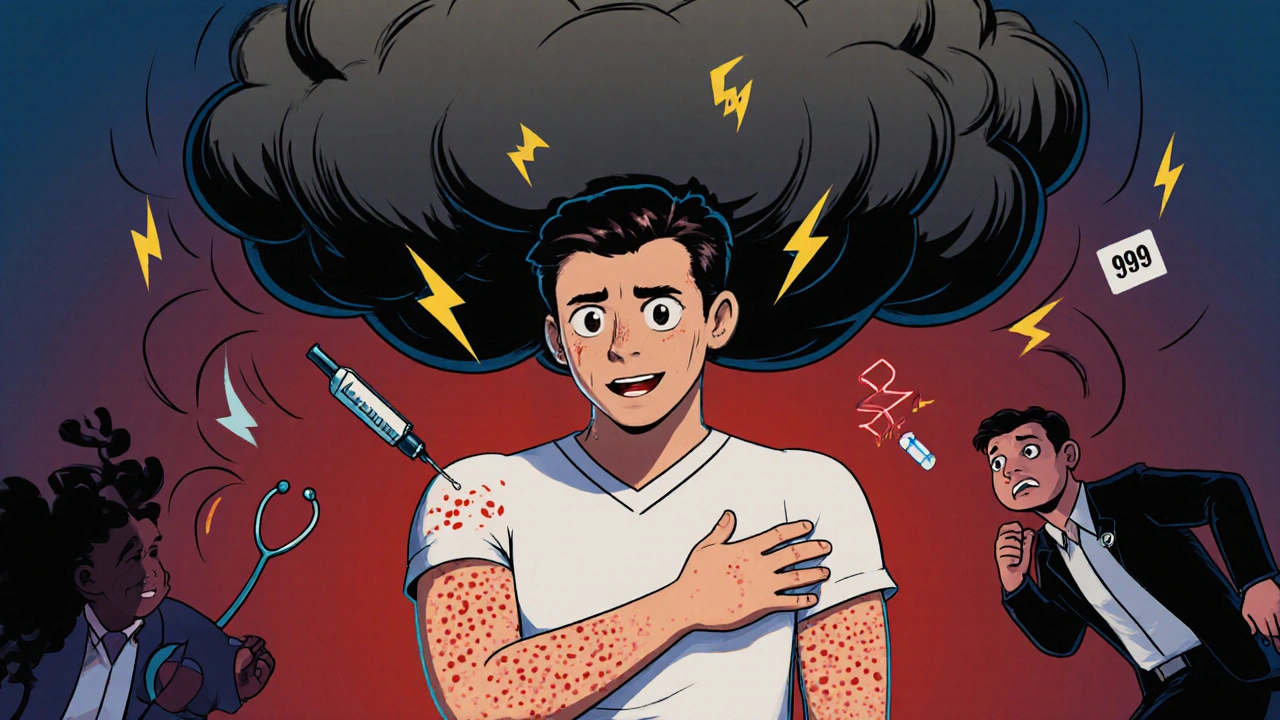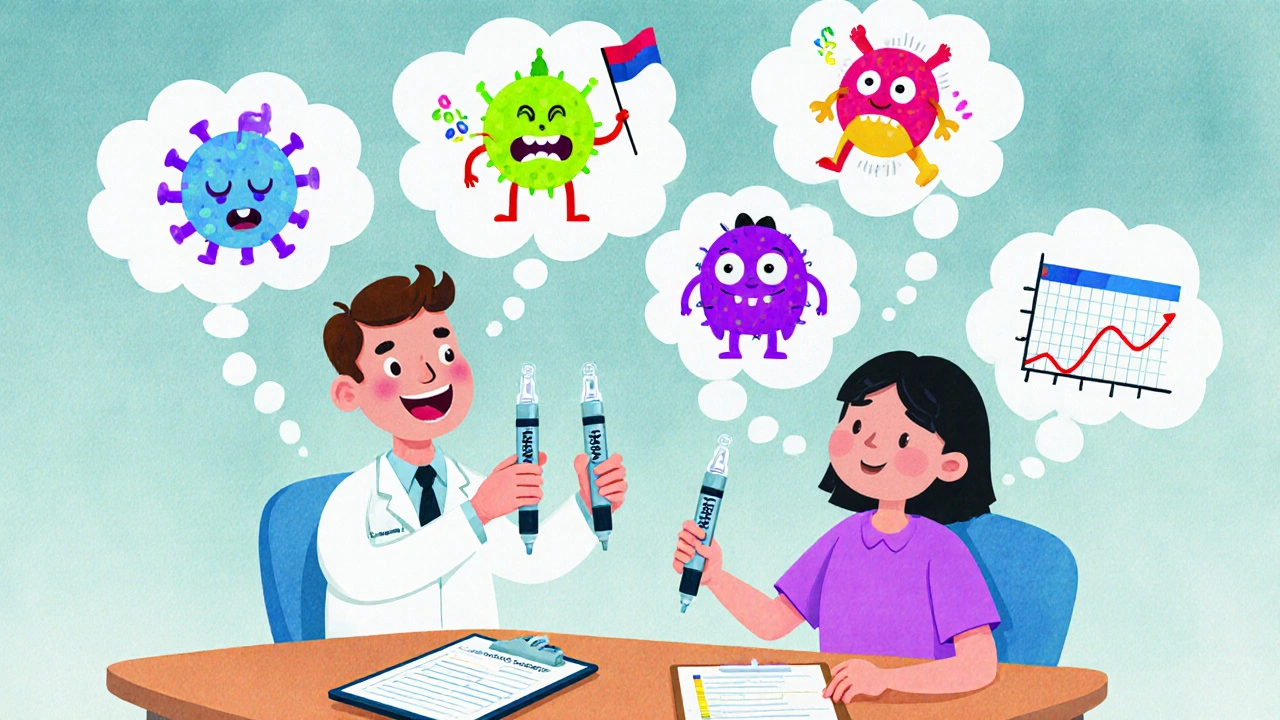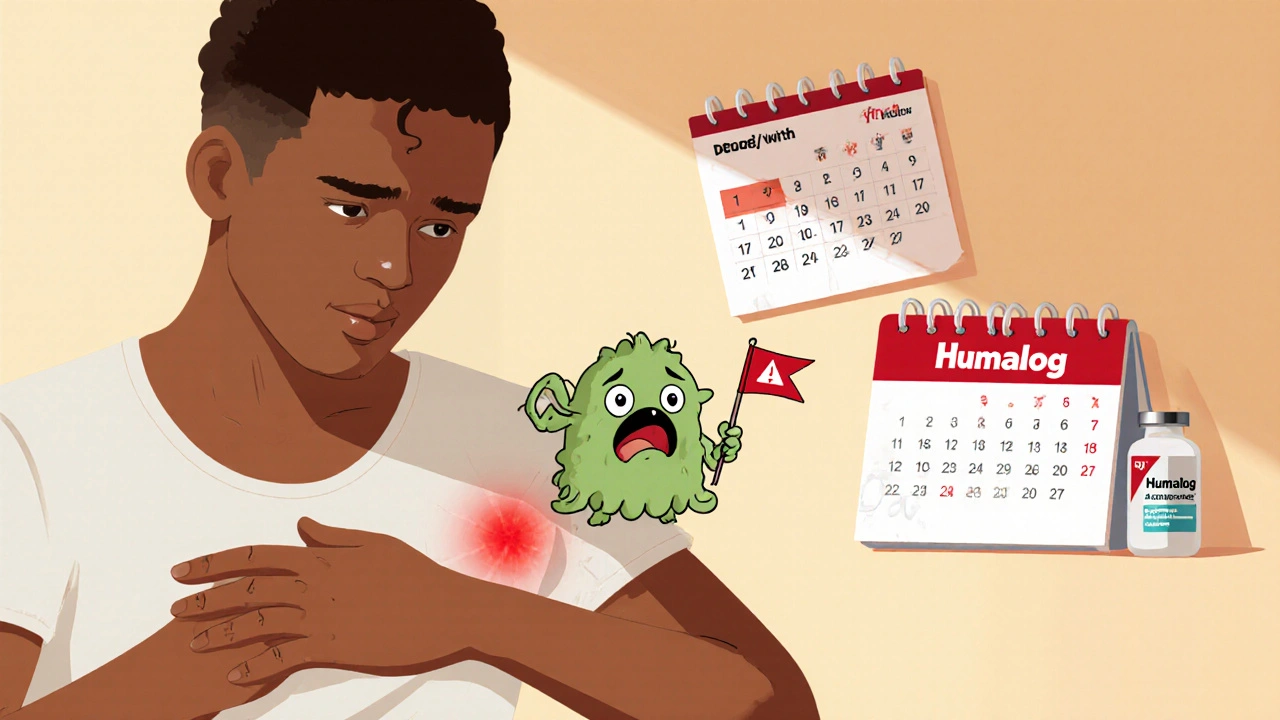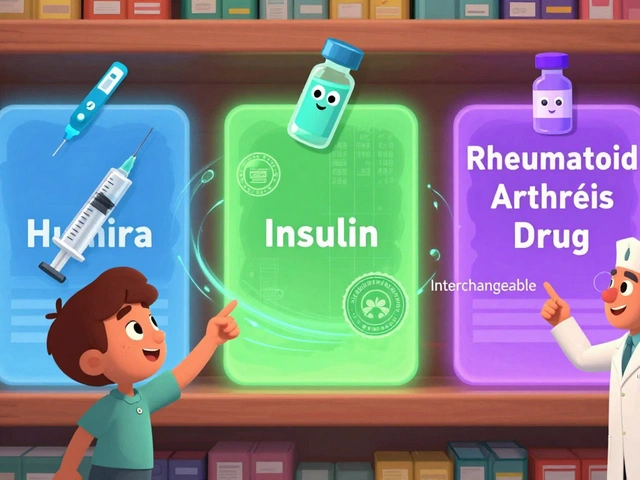Most people with diabetes assume that if they have a reaction at the injection site, it’s just irritation or a bad needle. But sometimes, it’s something more serious: an insulin allergy. It’s rare - affecting about 2 in 100 people - but when it happens, it can be dangerous if ignored. You might get redness, swelling, or itching right after injecting. Or, worse, you could start having trouble breathing, your throat could swell, or your whole body breaks out in hives. These aren’t just side effects. These are immune responses. And they need immediate attention.
What an Insulin Allergy Really Looks Like
Not all reactions are the same. There are three main types, and knowing which one you’re dealing with changes everything.Localized reactions are the most common. They show up right where you injected: red, swollen, itchy skin. Sometimes, a hard lump forms under the skin - not a bruise, not an infection, but a tender nodule. These usually show up within 30 minutes to 6 hours after the shot. In 85% of cases, they fade on their own within 2 days. But if they keep coming back, or get worse, don’t brush them off. This could be your body reacting to the insulin molecule itself, or more often, to the additives like metacresol or zinc used to stabilize the formula. Humalog, for example, has more metacresol than other insulins - and that’s been linked to more skin reactions.
Systemic reactions are rare, but life-threatening. Less than 1 in 1,000 people experience these. Symptoms include hives over large areas of the body, swelling of the lips, tongue, or throat, wheezing, dizziness, or a sudden drop in blood pressure. These happen within minutes of injection. This is anaphylaxis. It’s not a delay. It’s an emergency. If you’ve ever had a severe peanut allergy, think of this the same way. Call 999 immediately. Don’t wait. Don’t drive yourself. Don’t hope it goes away.
Delayed reactions are the trickiest. You might have used the same insulin for years - no problems. Then, out of nowhere, you wake up with joint pain, muscle aches, or a rash that looks like a bruise. These can appear 2 to 24 hours after injection and last for days. This isn’t IgE-mediated like the immediate reactions. It’s T-cell driven, meaning your immune system is slowly building a response. It’s not an emergency, but it’s still an allergy. And if you keep injecting, it can get worse.
Differentiating Allergy from Common Side Effects
It’s easy to confuse an allergy with regular insulin side effects. Sweating, shaking, feeling anxious - those are signs of low blood sugar. They’re not allergies. A true allergic reaction involves your immune system attacking something in the insulin. That means swelling, itching, hives, or breathing issues - not just feeling off.The NHS makes this clear: if you’re sweating and trembling, check your glucose. If you’re swelling and itching, call your diabetes team. Two very different responses. Mixing them up can delay treatment or lead to dangerous decisions - like stopping insulin because you think you’re having a low, when you’re actually having an allergic reaction.
What Causes It? It’s Not Always the Insulin
Many assume the insulin molecule itself is the problem. But research shows that’s not always true. In fact, modern human insulin and analogs are far less likely to cause allergies than the animal insulins from the 1930s. Back then, up to 15% of users had reactions. Today, it’s under 3%.The real culprits? Excipients - the additives that keep insulin stable. Metacresol, zinc, phenol, and protamine are common. Some people react to these chemicals, not the insulin. That’s why switching insulin brands can help. If you’re on Humalog and getting rashes, trying Lantus or NovoRapid might solve the problem. One study found that changing insulin types worked for 70% of allergic patients.
Even the injection technique matters. Reusing needles, injecting into scar tissue, or not rotating sites can cause irritation that looks like an allergy. Make sure you’re using fresh needles, rotating your injection areas (abdomen, thighs, arms), and not injecting into areas that are already red or swollen.

How Doctors Diagnose It
If you suspect an allergy, your diabetes team won’t guess. They’ll refer you to an allergist. Here’s what happens:- Skin prick test: Tiny amounts of different insulins and additives are placed on your skin. If you react, a red bump appears within 15-20 minutes. This identifies IgE-mediated allergies.
- Intradermal test: A small amount is injected just under the skin. Used when skin prick results are unclear. More sensitive, but riskier - so it’s done carefully.
- Blood test: Measures specific IgE antibodies to insulin or excipients. Helps confirm the diagnosis.
- Challenge test: In a controlled hospital setting, you’re given a tiny dose of insulin while being monitored. Used when tests are inconclusive.
Don’t skip this step. Without proper testing, you might switch insulins unnecessarily - or worse, stop insulin entirely. That’s dangerous. People with type 1 diabetes can’t survive without it. Diabetic ketoacidosis (DKA) can kill you faster than an allergic reaction if you stop treatment.
How to Manage It - Step by Step
For mild, localized reactions:
- Apply a topical calcineurin inhibitor like tacrolimus or pimecrolimus right after injection. Repeat 4-6 hours later. This suppresses the immune response without steroids.
- Or use a mid-to-high potency steroid cream (like flunisolide 0.05%) twice daily for 3-5 days. Don’t use it long-term unless directed.
- Take an oral antihistamine (like cetirizine or loratadine) daily. It won’t fix the swelling, but it reduces itching and prevents scratching that can cause infection.
For persistent or severe reactions:
- Switch insulin type. Try a different brand or formulation. If you’re on a rapid-acting analog, try a long-acting one - or vice versa. Many patients find relief this way.
- Try insulin desensitization. This isn’t magic. It’s slow, controlled exposure. Under medical supervision, you get tiny doses of insulin, gradually increasing over days or weeks. Studies show it works in about two-thirds of cases. One study of four patients found 66% had complete symptom resolution. The rest improved significantly.
- Use a different injection device. Some pens or pumps deliver insulin more consistently. Less irritation means fewer reactions.
For systemic reactions (anaphylaxis):
- Call 999 immediately.
- Use an epinephrine auto-injector if you have one.
- Do not drive yourself to the hospital.
- Once stabilized, you’ll need long-term management - usually a switch to a non-allergenic insulin and possibly desensitization.

What Doesn’t Work - And What Could Make It Worse
Some people think skipping doses will help. It won’t. The Independent Diabetes Trust warns that inconsistent insulin use can actually make allergies worse. Your immune system gets confused. It sees insulin one day, then nothing the next. That can trigger stronger reactions later.
Another myth: natural remedies. Essential oils, herbal creams, or “detox” diets won’t help. They might even irritate your skin more. Stick to evidence-based treatment.
And don’t assume you’re “over it.” Delayed reactions can appear even after 10 years of safe use. One patient in a study developed joint pain after using human insulin for over a decade. No one saw it coming. That’s why keeping a symptom diary matters. Note the date, time, insulin type, dose, location, and symptoms. Patterns emerge over time.
What Comes Next - The Future of Insulin Allergy Care
Research is moving fast. New insulin analogs are being designed with fewer excipients. Some are being tested without metacresol entirely. That could cut allergy rates even further.
Doctors are also exploring biomarkers - blood tests that predict who’s likely to react before it happens. Right now, we’re reacting after the fact. In the future, we might prevent it.
Continuous glucose monitors (CGMs) are already helping with desensitization. They let doctors see how your blood sugar responds to tiny insulin doses without risking dangerous lows. That makes the process safer and more precise.
But for now, the message is simple: don’t ignore it. Don’t assume it’s just irritation. If you’re having unusual reactions, talk to your diabetes team. Get tested. Don’t stop insulin. There are solutions. You don’t have to give up your treatment.
When to Act - Quick Decision Guide
Here’s what to do based on your symptoms:
- Redness, itching, small lump at injection site: Call your diabetes nurse. Don’t wait. Start antihistamines and topical cream.
- Hives, swelling, trouble breathing: Call 999. Use epinephrine if you have it.
- Joint pain, bruise-like rash 12+ hours after injection: Log it. Make an appointment with your allergist.
- Reaction every time you use the same insulin: Switch brands - but only under medical supervision.
Can you outgrow an insulin allergy?
No, insulin allergies don’t go away on their own. Unlike some childhood food allergies, this is a lifelong immune response. But with proper management - switching insulins, desensitization, or using topical treatments - symptoms can be controlled completely. You don’t have to live with them.
Is insulin allergy more common in type 1 or type 2 diabetes?
It’s slightly more common in type 1 diabetes, simply because those patients use insulin daily from a young age, giving the immune system more exposure. But it can happen in anyone using insulin - including type 2 patients who’ve been on it for years. The key factor is immune response, not diabetes type.
Can you use insulin pumps if you have an allergy?
Yes - but only after identifying the cause. If the allergy is to the insulin molecule, switching to a less immunogenic analog may help. If it’s to an excipient, some pump-compatible insulins have cleaner formulations. Always test new insulins in a supervised setting before switching to a pump.
Are there any insulin brands that are less likely to cause allergies?
Some newer insulins, like Fiasp and Toujeo, have reduced or different excipients than older versions. Humalog has higher metacresol levels, which is linked to more skin reactions. Lantus and Levemir use different preservatives and are often better tolerated. But there’s no one-size-fits-all - testing is required to find what works for you.
What happens if I stop taking insulin because of an allergic reaction?
Stopping insulin - even for a day - can trigger diabetic ketoacidosis (DKA), a life-threatening condition. This is especially dangerous for people with type 1 diabetes. Never stop insulin without medical supervision. Your diabetes team can help you switch safely or start desensitization while keeping your blood sugar stable.
Can children develop insulin allergies?
Yes. Children with type 1 diabetes can develop allergic reactions, sometimes within weeks of starting insulin. Parents should watch for unusual swelling, crying during injections, or unexplained rashes. Pediatric endocrinologists and allergists work together to manage these cases - often with successful outcomes using desensitization or insulin switching.







For anyone dealing with localized reactions, I’ve found that switching to a different injection site rotation pattern makes a huge difference. I used to inject in my abdomen every time, and the lumps kept coming back. Started alternating with thighs and arms-no more nodules. Also, always use a new needle. Reusing even once can cause micro-trauma that mimics an allergic response. Don’t underestimate technique.
Let me break this down for you all-this isn’t even close to being as rare as they claim. I’ve seen *three* patients in my clinic alone with IgE-mediated insulin allergies in the last year. And no, it’s not just metacresol-it’s the *zinc protamine complex* in NPH that’s the real culprit. Most docs don’t even know that. Also, why are they still recommending Lantus? It’s got phenol, which is a known sensitizer. Try Fiasp. Or better yet-go back to animal insulin. Yes, I said it. Bovine insulin has fewer additives. The FDA banned it for no good reason. 😒
Wait, so you’re telling me people are allergic to insulin? Like… the actual hormone? That’s wild. I thought insulin was just sugar medicine. And now you’re saying you can’t just stop taking it? So what, you’re stuck with it forever? Even if your skin turns into a red, itchy mess? That’s not fair. You should be able to just… not take it. Like, if your body says no, why force it? 😕
⚠️ IMPORTANT: This article is dangerously incomplete. No mention of IgG4-mediated delayed hypersensitivity? No discussion of basophil activation tests? No reference to the 2023 JACI meta-analysis on excipient immunogenicity? The NHS guidelines cited are from 2019-outdated. Also, why no mention of insulin analogs with PEGylated formulations? Those are in phase 3 trials and show 92% reduction in cutaneous reactions. You’re giving people outdated advice. This is why medical misinformation spreads. 🧪
Let me guess-Big Pharma made this up. They *want* you to think you’re allergic so you’ll keep buying new pens, new insulins, new creams. Why do you think they stopped making animal insulin? Because it was cheap. Now? You pay $300 for a vial that’s basically synthetic sugar water with a side of chemical soup. They profit from your confusion. Don’t fall for it. Your body isn’t allergic-it’s screaming at the toxins. Try fasting. Try detoxing. Stop trusting doctors who get paid by the companies.
so like… insulin allergies are real? but only if you’re american? because in india we’ve been using animal insulin for decades and no one ever had a problem? also why are we blaming metacresol? maybe it’s the plastic in the pen? or the water? or the air? i mean… everything is allergic now. i think we’re just overdiagnosing. also i tried a new insulin and got a rash. so i stopped. now my sugar is 400. so… yeah. 🤷♀️
This is the kind of post that makes me feel seen. I had a delayed reaction for 18 months and thought I was just getting older. Joint pain, fatigue, bruise-like marks… I thought it was arthritis. Turns out it was insulin. My endo didn’t even consider it. I’m so glad someone wrote this. If you’re reading this and you’ve had weird symptoms for years-don’t ignore them. Get tested. You’re not crazy. It’s real. And you’re not alone.
lol so i switched from humalog to novorapid and my rash went away… but now my sugar is all over the place. like… why does everything have to be a tradeoff? can’t we just have insulin that works AND doesn’t make me itch? also why is everyone so obsessed with excipients? i think the real problem is we’re injecting chemicals into our bodies like they’re energy drinks. 🤔
Thank you for the clear, evidence-based overview. The distinction between localized, systemic, and delayed reactions is critical. I will share this with my diabetes education group. Proper diagnosis prevents dangerous mismanagement. Well done.
I’ve been managing a mild reaction for 5 years with topical tacrolimus and oral loratadine. It’s not perfect, but it’s manageable. I switched from Humalog to Fiasp and haven’t had a flare since. The key is consistency-don’t skip doses, don’t panic, and don’t try to ‘fix’ it with coconut oil. Trust the science. You can live well with this. I am.
So… what’s the point? I just need to know if I can keep using my pen or if I need to buy a new one. This is too much reading.
Wow this is so overcomplicated. All you need to know is stop taking insulin. I did it. I went keto. My sugar’s fine now. No more itching. No more shots. No more pharma lies. You think you need insulin? You don’t. Your body’s telling you something. Listen. I’ve been insulin-free for 3 years. I’m healthier than ever. You’re just scared to let go.